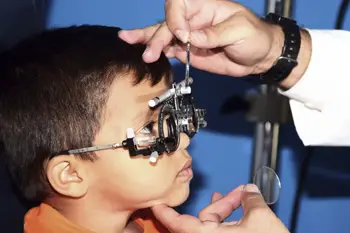Young children can have eye problems that standard school screening tests don’t pick up. Get advice on the best way to have your child’s vision assessed so he can perform his best in school.

School is now in session. Every parent’s back-to-school checklist surely included pencils and knapsacks and, of course, immunizations. But did it include a trip to the eye doctor?
Eighty percent of learning is through the visual system. So surely an eye exam at the eye doctor should also be on your back-to-school checklist. Yet a recent survey showed that 76 percent of children below the age of 5 have never had a comprehensive eye exam with an eye doctor.
Most parents rely on school and pediatrician vision screenings, assuming these to be eye exams. But that’s like having one’s blood pressure checked in place of a complete physical examination. Unlike a thorough eye exam, a standard vision screening using just an eye chart identifies about 5 percent of vision problems in children.
Vision screenings only check a child’s distance vision — his or her ability to see well at 20 feet away. Yet the child’s ability to see well up close, such as while reading a book or using the computer — so very critical for good performance in the classroom – is rarely assessed in screenings.
An eye chart can’t check how well children coordinate their eyes when reading, how easily they can adjust focus from near to far distances, or their ability to move their eyes across a line of print without losing their place.
What Eye Exams Detect
When children have eye teaming or coordination problems, they may actually see double. A small misalignment of the two eyes may rob children of the energy needed to concentrate and get meaning from what they read. Difficulty with eye focusing skills means that a child may be unable to keep the print clear while reading. Children may also be challenged shifting their visual focus back and forth, near and far, when copying information from the blackboard. Finally, a child’s inability to appropriately track words while reading may also contribute to poor learningperformance.
One of the most common vision problems experienced by children is being farsighted. Farsighted kids can usually see the blackboard fine, but get tired when they read up close.
It is important to understand that only an eye doctor can perform eye tests that can detect and rule out eye conditions such as glaucoma, tumors, lazy eye, and mild farsightedness. In addition, conditions that are becoming increasingly prevalent in children, such as diabetes, high blood pressure and cholesterol, can be detected in the eye, by an eye doctor, long before other symptoms of these serious conditions are evident elsewhere in the body.
And what of the many hours children now spend on computers and in front of video games? Children spend an average of four or more hours a day engaged in these activities, which strain the eye and can lead to Computer Vision Syndrome (CVS) in children just as in adults. CVS is a serious vision issue that can cause many symptoms, including any of the following: blurred vision, headaches, sleepiness, nearsightedness, and neck and shoulder pain.
Another concern in regard to children’s vision is the sun protection (or lack thereof) that children endure. While 68 percent of adults wear sunglasses outdoors, fewer than 30 percent of children do so.
The message? Schedule annual appointments with an eye doctor. Every child deserves a comprehensive eye exam, one that includes a thorough evaluation of all tasks that directly affect one’s reading comfort and efficiency. These skills, so crucial for good school performance, are unfortunately often not assessed when children are screened in preparation for school. Indeed, one in four children struggle with reading and school work because of undiagnosed vision problems. A good idea: When you book your child’s yearly appointment with the dentist, remember to follow it up with another quick call to schedule an eye doctor session, as well.
Dr. Michal Luchins is an optometrist who specializes in Vision Therapy and Developmental Optometry and is certified in Early Childhood Education and Processing and Cognitive Enhancement. Her practice, Family Vision & Learning Center, is located in Suffern, NY.
Also see: 3 Tips to Improve Your Family’s Eye Health





















